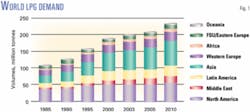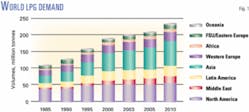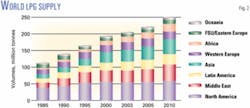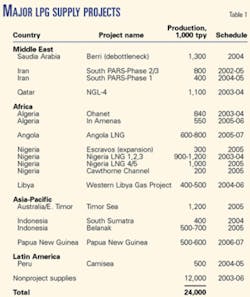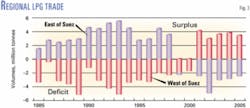Global demand for LPG has grown rapidly for many years. Much of this growth has occurred in regions east of the Suez Canal, which has shifted international trade patterns. Growth slowed slightly in 2003 as many nations experienced weak economies and high LPG prices.
As economies begin to rebound, modest growth will return to the LPG market. LPG supplies will continue to increase, in part due to a number of new projects associated with either domestic gas production or LNG export projects.
In the past 10 years, the global market for LPG has grown at about 2.9%/year, or roughly two times faster than demand for petroleum.
LPG demand by developing nations with large populations grew very rapidly as a result of robust economic growth, which resulted in an increase in discretionary income and spending by consumers. LPG use as a petrochemical feedstock also increased at high rates.
The global LPG industry in 2004 will face challenges that could slow demand growth. The war on terrorism has increased global concerns about security of supply and helped sustain high prices.
These prices are slowing economic growth and have tempered demand for all types of energy, including LPG. Increased penetration of natural gas in developing countries also is putting downward pressure on LPG demand.
In North America, the LPG industry has been experiencing an extremely tight market for natural gas, which has squeezed gas processing margins.
The resulting higher NGL prices have adversely affected the regional petrochemical industry's ability to compete in the global market. Currently, high oil prices are supporting gas processing margins, but future economic conditions are uncertain given the high price of natural gas that appears likely to continue.
In the face of factors that could depress demand, new LPG production projects will continue to be started and existing facilities expanded.
Thus, the world LPG market could shift from the demand-driven market that was experienced during the 1990s and early 2000s, to a supply-driven market in the second half of this decade.
Rapid demand growth
Total global LPG demand in 2003 was 207 million tonnes. In 2004, Purvin & Gertz Inc. estimates that demand will increase further to about 215 million tonnes.
By 2005, LPG demand will total about 222 million tonnes/year (tpy), or 33% over the total of 167 million tpy in 1995 (Fig. 1).
Since 1995, total global demand growth for LPG averaged 2.7%/year. Growth rates varied significantly, however, in different geographical regions.
In general, developing areas experienced the highest growth rates while Western Europe and North America experienced minimal growth.
On an absolute basis, demand in the Far East grew the fastest from 1995 to 2003 with an increase of 12 million tpy.
Southeast Asia, the Indian subcontinent, and Latin America all exhibited strong demand growth that was primarily driven by the residential-commercial sector. Middle East demand also grew strongly (7.7 million tpy) in the same period but its growth came chiefly from petrochemical demand.
Asia
The Far East is currently the second largest LPG consuming region behind North America with demand having increased there by 4.0%/year since 1995. The growth rate is very robust considering the large size of the market, which totaled 44.3 million tonnes in 2003. More than 60% of total demand in the region is for use in the residential-commercial sector.
Within the region, Japan is the largest consumer of LPG, using more than 18 million tpy for the last several years. LPG consumption in China, however, has soared and is rapidly approaching Japan's consumption level. China has experienced a growth rate of 14%/ year since 1995 compared to a slight contraction of 0.5%/year in Japan. Purvin & Gertz expects China's LPG demand to grow at about 5%/year for the next few years and exceed Japan's consumption level in 2-3 years.
Southeast Asia is a small market when compared to the Far East, but its LPG demand growth averaged 7.6%/year since 1995. Total LPG demand grew to 8.4 million tpy in 2003 from 4.7 million tpy in 1995.
Together, Malaysia and Thailand make up about 60% of the total demand in the region.
Most countries except Singapore have experienced high rates of LPG demand growth since 1995. About three-quarters of the LPG are consumed in the residential-commercial sector.
This sector will grow by more than 5%/year through 2010, resulting in significant overall LPG demand growth in the region. Thailand and Viet Nam seem poised for very significant LPG demand growth through the end of the decade.
The neighboring Indian subcontinent experienced explosive growth in LPG demand of 10.5%/year between 1995 and 2003.
Total demand rose by about 4.7 million tpy since 1995 to 8.5 million tpy in 2003. India accounts for roughly 95% of the LPG consumption in the region.
The vast majority of the LPG used in the region is consumed by the residential-commercial sector.
Continued economic development in this heavily populated region will lead to sustained growth in LPG demand, albeit at a somewhat slower pace. Purvin & Gertz expects growth rates to slow to about 7%/year through the end of the decade.
Latin America; Middle East
Latin America is another large market for LPG that experienced robust growth since 1995. Demand grew 5.1 million tpy (2.6%/year) since 1995. More than 80% of the LPG is consumed in the residential-commercial sector.
Demand has contracted slightly to 27.3 million tpy in 2003 from 28.6 million tpy in 2000. This can be attributed to economic recessions in many countries as well as the increased use of natural gas in Brazil and Mexico.
Together, these two countries represent 62% of demand in the region. Going forward, we expect that economic conditions will improve and that this will result in increasing demand for LPG.
Unlike the previous regions, LPG demand growth in the Middle East has been heavily influenced by the petrochemical sector that uses it as feedstock. Saudi Arabia currently accounts for slightly more than half the total LPG consumption in the Middle East. Demand soared to about 8 million tonnes in 2003 from only 3.1 million tonnes in 1995, primarily due to increased use as a petrochemical feedstock for the production of methyl tertiary butyl ether (MTBE) and ethylene.
Demand in Saudi Arabia will likely grow very slowly over the next few years as the focus shifts to the construction of new ethane-based cracking capacity. Demand in the kingdom should then begin to accelerate as new LPG-based capacity is brought on-line toward the end of this decade.
Iran is the second largest consumer of LPG in the Middle East, accounting for about 18% of the total regional demand. Unlike Saudi Arabia, LPG demand in Iran has grown more slowly, averaging about 6.4%/year since 1995.
Historically, virtually all LPG consumed in Iran was used by the residential-commercial sector. A new olefins manufacturing complex, however, began using small amounts of LPG as feed in 2003.
The planned expansion of the petrochemical industry in the country will likely be based primarily on ethane and naphtha.
Thus, LPG demand growth in the near future should continue to come from the residential-commercial sector, which Purvin & Gertz expects to increase at about 4%/year.
Eastern Europe; Africa
LPG demand in Eastern Europe also increased rapidly, averaging 7.2%/year from 1995 to 2003. Before 1995, demand fell sharply as severe economic problems resulted from the collapse of the former Soviet Union.
Somewhat less impressive is the absolute increase in demand, which rose by about 1.2 million tpy to current demand of nearly 2.9 million tpy in 2003.
Thus, on an absolute basis, Eastern Europe ranks only 10th out of the 11 major LPG-consuming regions of the world.
Poland, the largest LPG consumer in Eastern Europe, accounts for roughly half of the total demand in the region. The residential-commercial sector consumes about 45% of all LPG used in the region.
The fastest growing demand sector, however, is for auto fuel, which accounted for about 39% of the total in 2003.
Most of this auto fuel market occurs in Poland, with the balance in the Czech Republic and Bulgaria. Purvin & Gertz's believes demand in the region to grow by about 3%/year with much of this growth coming from the auto fuel market.
The African LPG market is similar to Eastern Europe in that it has been growing quickly, averaging about 5.1%/year since 1995. Currently, demand is about 8 million tpy.
About 95% of the LPG used in Africa is consumed in the residential-commercial sector.
Egypt consumes about a third of all LPG used in the region, followed by Algeria, which consumes about a quarter of the total. Purvin & Gertz expects that LPG demand in the region will grow at slightly more than 3.2%/year through 2010.
Slower demand growth
Oceania has the lowest regional LPG demand at about 2.7 million tpy. The region has experienced growth of about 1.9%/year since 1995.
Australia accounts for the vast majority of LPG consumption in the region.
Unlike any other region in the world, auto fuel demand dominates consumption at almost 65% of the total. Purvin & Gertz expects that total LPG demand in the region will grow at about 2.9%/year through 2010.
North America is one of the three regions in which LPG demand grew more slowly than the world average. Demand growth there has averaged only 0.5%/year since 1995. Despite the small growth rate, total demand grew by just over 2.1 million tpy over the same period. It remains the largest market in the world for LPG with more than 57 million tpy of demand.
The LPG market in North America is unique in that the production of petrochemicals makes up an unusually large share (40-45%) of the consumption.
This market share fluctuates based on the relative economics of cracking LPG vs. either ethane or naphtha-gas oil.
Because LPG demand for most end-uses is very mature in North America, future growth primarily depends on the petrochemical feedstock market. Purvin & Gertz currently expects total LPG demand to increase at about 2-3%/year through 2010, depending on the health of the petrochemical industry.
This market is somewhat at risk, however, due to high prices for natural gas that have driven up LPG prices. These higher feedstock prices have damaged the region's ability to compete in the global petrochemical market and could slow the potential growth in LPG demand.
Western Europe is also a mature market for LPG with an average growth rate of only 0.3%/year since 1995. The region is the fourth largest market for LPG in the world, however. Thus, the relatively slow growth rate amounted to an increase of 0.6 million tpy since 1995.
The top five consuming countries in Western Europe in 2003 were (in order) Italy, France, Turkey, Spain, and the UK. LPG demand in the residential-commercial sector accounts for about 40% of the regional total. The industrial sector, auto-fuel market, and petrochemical feedstock market, however, all make up fairly large segments of the total.
The last region in which LPG demand rose more slowly than the world average is the former Soviet Union (FSU).
Because of the very weak economy, demand in the FSU declined steadily between 1990 and 1998. In 1999, however, demand started to rebound and has increased by an average of about 3.6% for the last 5 years, reaching about 5.4 million tonnes in 2003.
Russia accounts for about three fourths of the total LPG consumption in the region. The residential-commercial sector uses about 55% of the total. Also, Russian-based petrochemical companies consume roughly 35% of the total.
New supply projects
Global supply of LPG has risen to about 207 million tonnes in 2003 from 166 million tonnes in 1995. Thus, supply increase has averaged about 2.7%/year. Purvin & Gertz looks for supplies to reach about 251 million tpy by 2010 (Fig. 2).
LPG production from natural gas consistently accounted for about 60% of the total supplies during the last 10 years. Refineries typically produced most of the remainder, with other miscellaneous sources accounting for roughly 1%.
Although the sources of supply have remained fairly constant, regional production rates have shifted noticeably.
In 1990, LPG produced in regions east of Suez Canal ("East of Suez") produced slightly less than 30% of the world total. In 2000, East of Suez's share of the total had risen to nearly 35%.
By 2010, Purvin & Gertz estimates that almost 40% of world's LPG supplies, or about 100 million tonnes, will come from East of Suez.
On a percentage basis, production increases have been particularly high in the Indian subcontinent, averaging 10.2%/year between 1995 and 2003, followed by Africa at 9.5%/year.
Supplies also rose quickly in both the Far East and Southeast Asia, at 8.6%/year and 5.0%/year, respectively. The regional ranking is somewhat different when based on the total increase, however.
During the past 8 years, LPG production increased by 40 million tpy. The largest increase, 9.4 million tpy, was in the Far East. Production from African countries increased by 8.5 million tpy. Other regions contributing to the growing supply were the Middle East (5.2 million tpy), Latin America (5.2 million tpy), the Indian subcontinent (3.9 million tpy), and Southeast Asia (3.2 million tpy). No regions experienced production declines over this period.
The increase in the Far East primarily resulted from rapidly rising LPG production by refineries in both Korea and China. Essentially all production in this region is from refineries. In the future, we expect continued growth in supplies from refineries.
In Africa, most of the increase in LPG production came from Algeria where production increased to slightly more than 10 million tonnes in 2003 from 5 million tonnes in 1995. Purvin & Gertz expects production growth to slow in Algeria over the next several years.
Nigeria also increased its production of LPG significantly as crude oil production increased and natural gas began to be processed instead of flared. Production from Nigeria will contribute significantly to African supplies through the rest of the decade.
The government continues to emphasize reduced flaring of gas and monetization of the resource. Nigerian LPG production will likely increase to more than 5 million tpy by 2010 from about 2 million tpy now.
Production growth in the Middle East was strong over the past 8 years. Iran, the UAE, and Qatar contributed greatly to the regional supplies. Production from Iraq had held steady through 2002, but dropped in 2003 as a result of the war.
Natural gas processing was the primary source of the increase in LPG production in the region. The future will see strong growth in LPG production as Iran, Saudi Arabia, Qatar, and the UAE continue to develop new and existing gas reserves.
LPG production in Latin America was 25 million tonnes in 2003 and ranked third in the world behind North America and the Middle East. Mexico is the largest producer in the region with about 7.5 million tpy, but there has been little production growth from the country in the last 8 years. Most of the supply growth has come from Brazil, Venezuela, and Argentina.
The future promises continued growth in supply from these countries and from Peru where the Camisea gas field will begin production later this year. Currently, LPG production from natural gas makes up about 61% of total supplies. We expect that increased natural gas production in the region will drive this figure to 66% by end of the decade.
The Indian subcontinent had significant growth in LPG supplies of more than 10%/year since 1995. But the region only produces about 7 million tpy, and about two thirds of this production comes from refineries. India is the dominant producer in the region with more than 94% of the production. LPG production will increase to about 9.5 million tpy by 2010 and most of the increase will come from refinery production.
Over the last decade, Southeast Asia LPG production was boosted by Thailand and Malaysia. Supplies from these countries increased as gas processing capacity was added and refinery production increased.
Supplies from Indonesia have decreased since 1995 because of lower production from the Bontang and Arun LNG plants. Civil unrest forced the shutdown of the Arun facility and its future remains uncertain.
In the future, production will likely grow at about 3.5%/year in the region. This assumes that the political situation in Indonesia stabilizes and that Malaysia and Thailand continue to expand supplies moderately.
Production of LPG in Viet Nam will grow significantly from current levels, especially if a planned refinery project comes to fruition.
Western Europe is the fourth largest producing region in the world and its supplies have grown by 0.9%/year since 1995, with production from the North Sea constituting about a quarter of Western Europe LPG supplies. Overall, about 60% of the production is from refineries.
Production will remain near current levels as increased supplies from refineries offset declining North Sea supplies.
Since 1995, production from the former Soviet Union has increased by 1.3 million tpy to 7.0 million tonnes in 2003. Future growth in LPG supply is likely as the FSU expands development of its crude oil and natural gas resources.
North America is the largest source of LPG supplies in the world, a dominant position not likely to change through 2010.
Production grew only 0.2%/year since 1995 but will likely be slightly higher through 2010. Total LPG production in the US peaked at 36.9 million tons in 2000, which was 6% higher than in 1995. Production then declined by 6% in 2003 due to poor gas processing margins (Editor's note: See accompanying lead article for more on this development.)
Of the remaining two regions since 1995, LPG production in Oceania rose by about 800,000 tpy, while production in Eastern Europe inched up by only 140,000 tpy.
Future production rates
Purvin & Gertz's forecast of future LPG production rates is based partly on announced projects (Table 1) that account for an increase of about 12 million tpy between 2003 and 2006.
New projects in the Middle East should add about 3.6 million tpy of LPG production to the world markets. Production projects in Africa are to add roughly 4.0 million tpy.
In Asia-Pacific, four new projects will increase LPG production in the region by about 2.7 million tpy.
Finally, the Camisea project in Peru will produce about 500,000 tpy of LPG.
These projects all are primarily intended to increase natural gas production, for either domestic use or for LNG exports.
LPG must be extracted by these facilities so that the gas or LNG can be marketed.
In addition to specific projects that are listed in Table 1, LPG production will increase from a huge number of existing facilities around the world.
The amount of additional LPG that will be produced by these facilities is difficult to determine accurately, but Purvin & Gertz estimates that LPG production from these miscellaneous sources will add about 12 million tpy of LPG to the world markets.
Changing trade patterns
A careful review of the preceding descriptions of LPG demand and supply shows that an interesting shift is occurring in the global LPG market.
Demand in the five regions East of Suez increased by a total of almost 29 million tpy between 1995 and 2003. Demand in the regions West of Suez increased by only 12 million tpy during the same period.
At the same time, LPG production in the regions East of Suez rose by only about 23 million tpy since 1995.
Production West of Suez increased by nearly 18 million tpy.
Due to this shift of approximately 6 million tpy, the LPG supply-demand balance East of Suez has shifted from a surplus of supplies to a deficit, whereas West of Suez has experienced an equal but opposite shift in its balance (Fig. 3).
These relative changes in the supply-demand balances have affected world LPG trade patterns.
The Far East remains the largest LPG importing region in the world and in recent years has required imports from increasingly diverse sources.
In the last few years, there have been LPG shipments from both West and North Africa to Far East destinations. Also, LPG from the North Sea has been exported to the Far East regularly. In 2003, however, these trade movements decreased somewhat as production increased faster than demand in the East of Suez region.
The US continues to be the swing destination for or supplier of LPG to the global market.
During periods of surplus supplies, the US often becomes the "dumping ground" for excess LPG from many producing regions.
Because of the extremely large LPG storage facilities along the US Gulf Coast, the excess LPG can be stored for future consumption within the US or for re-export to other regions as needed.
Our analyses indicate that the increase in global supplies of LPG will outrun the increase in base demand during the next few years. Therefore, discretionary consumption of LPG as a feedstock for petrochemical production (price-sensitive demand) will need to increase.
Purvin & Gertz estimates that price-sensitive demand will increase to roughly 11 million tpy by 2005 from about 4.9 million tpy in 2003.
Regional ethane markets
Ethane is seldom transported in ships from one region to another due to the high costs of shipping cryogenic products.
Despite that difficulty, ethane is an extremely important component of the global petrochemical industry.
Nearly all ethane is extracted from natural gas. Its physical properties are relatively similar to methane, which is the main component of natural gas. Therefore, ethane can either be left in the gas or extracted.
Whether to recover ethane generally depends on the economics of extracting it from the produced natural gas. If ethane is to be recovered, its price must be higher than the extraction and purification costs, including its gas-based heating value.
In 2003, ethane was used to produce about 27 million tonnes of ethylene, or approximately 28% of all ethylene produced in the world.
About 34 million tpy of ethane were consumed to produce this ethylene. Despite this very large market, ethane use is extensive in only a few regions of the world.
The largest regional use of ethane occurs in the US and Canada, which account for about 20 million tpy or approximately 60% of all the ethane consumed in the world.
Supplies of ethane are adequate in the US. Supplies from existing facilities in Canada, however, are falling behind demand. Therefore, new and expanded sources of ethane supplies are being evaluated.
During the last few years, Latin America (including Mexico) consumed slightly more than 2 million tpy of ethane, or about 7% of the global total. Similarly, ethane consumption in Western Europe averaged roughly 2 million tpy during the last few years.
Finally, the only other region of any significance to the global ethane market is the Middle East where consumption has grown as new olefins plants were added.
Ethane consumption should continue to rise during the next few years, reaching about 40 million tpy in 2005. Most of this expected increase should occur in the Middle East.
The authors
Alfred L. Luaces ([email protected]) is a principal in the Houston office of Purvin & Gertz Inc. After 9 years with ExxonMobil, he joined the firm in 2000. He holds a BS in mechanical engineering from the University of Florida and is a registered professional engineer in Texas.
Ajey Chandra ([email protected]) is a principal in the Houston office of Purvin & Gertz Inc. After 12 years with Amoco Corp., he joined Purvin & Gertz in 1998 and was elected a principal in 2000. He holds a BS in chemical engineering from Texas A&M University and an MBA from the University of Houston. He is a member of GPA and SPE.
Ronald L. Gist ([email protected]) is a senior principal in the Houston office of Purvin & Gertz Inc., joining the company in 1996. He began his career with E.I. DuPont de Nemours & Co. in 1971 after receiving both BS and MS degrees in chemical engineering from Colorado School of Mines. Gist is Purvin & Gertz's representative to GPA's market information committee.
Ken W. Otto ([email protected]) is a vice-president and director in the Houston office of Purvin & Gertz Inc. He joined E.I. DuPont de Nemours & Co. in 1977, then moved to Champlin Petroleum Co. in 1979 and served 4 years at Corpus Christi Petroleum Co. Otto joined Purvin & Gertz in 1986, was elected principal of the company in 1987, senior principal in 1990, and vice-president in 1997. He holds a BS (1977) in chemical engineering from the University of Texas at Austin.
S. Craig Whitley ([email protected]) is a senior principal in Purvin & Gertz Inc.'s Houston office. He joined the company in 1993, working in market analysis of natural gas, LPG, and NGL markets. Whitley has a BS in chemistry and zoology from Northwestern Louisiana State University, Nachitoches. He is a member of GPA, International Association of Energy Economists, National Propane Gas Association, and is Purvin & Gertz's representative on GPA's international committee.
